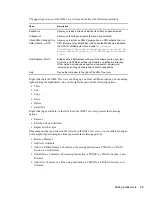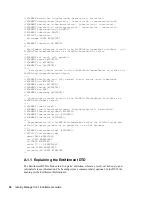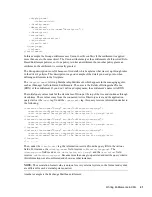
38
Identity Manager 3.6.1 Entitlements Guide
no
vd
ocx
(e
n)
13
Ma
y 20
09
<!ELEMENT value (#PCDATA)>
Entitlement values are untyped strings.
<!ELEMENT query-app (query-xml, result-set)>
If values come from an external application (such as an e-mail distribution list), you must specify an
application query through the
<query-xml>
element. You extract the results from the query through
the
<result-set>
element. We show two examples of this in
“Example 2: Application Query
Entitlement: External Query” on page 40
.
<!ELEMENT query-xml ANY>
XML queries are XDS-formatted. The
<query-xml>
command is used to find and read objects
from the connected application. The functionality for DirXML
®
rules, object migration, etc.
depends on the driver’s implementation of the query command. For more information on XML
queries, see the
Novell developer documentation on queries (http://developer.novell.com/ndk/doc/
dirxml/dirxmlbk/ref/ndsdtd/query.html)
.
<!ELEMENT result-set (display-name, description, ent-value)>
<!ELEMENT display-name(token-attr | token-src-dn | token-association)>
<!ELEMENT ent-value (token-association | token-src-dn | token-attr)>
<!ELEMENT description (token-association | token-src-dn | token-attr)>
<!ELEMENT token-association EMPTY>
<!ELEMENT token-attr EMPTY>
<!ATTLIST token-attr
attr-name CDATA #REQUIRED
Use the
result set
element to help you interpret the result of an external application query. There
are three pieces of data that are of interest: the display name of the value (the
display-name
child
element), the value’s description (the
description
child element), and the literal entitlement value
(the
ent-value
child element), which is not displayed.
The token elements
<token-src-dn>
,
<token-association>
,
<token-attr>
are actually
placeholders for XPATH expressions that extract the src-dn attribute value, association value, or any
attribute values respectively from an XDS-formatted XML document. The DTD assumes that the
query result is XDS.
A.1.2 Other Headings in the DTD
The remaining entitlement headings in the Entitlement DTD serve different functions, but they are
not items that you need to focus on when creating an entitlement.
<!--
Entitlement reference stored in the DirXML-EntitlementRef attribute of a
DirXML-EntitlementRecipient or a DirXML-SharedProfile object.
-->
The information stored in the Entitlement Reference portion of the DTD points to an entitlement
object. This information is placed there by the managing agent (such as the Role-Based Entitlement
driver,
Entitlement.xml
, or the Approval Flow driver,
UserApplication.xml
). This is the
triggering event for an action to take place in a connected system. You don’t need to do anything
with the DTD under this heading, but you can use this information to ensure that the entitlement
object is being referenced.
Summary of Contents for IDENTITY MANAGER 3.6.1 - ENTITLEMENTS
Page 4: ...4 Identity Manager 3 6 1 Entitlements Guide novdocx en 13 May 2009...
Page 6: ...6 Identity Manager 3 6 1 Entitlements Guide novdocx en 13 May 2009...
Page 8: ...8 Identity Manager 3 6 1 Entitlements Guide novdocx en 13 May 2009...
Page 12: ...12 Identity Manager 3 6 1 Entitlements Guide novdocx en 13 May 2009...
Page 26: ...26 Identity Manager 3 6 1 Entitlements Guide novdocx en 13 May 2009...
Page 44: ...44 Identity Manager 3 6 1 Entitlements Guide novdocx en 13 May 2009...





















